
Scythian descent claims refers to claims of descent from the Scythians, an Iranian people best known for dominating the Pontic steppe from about 700 BC to 400 BC. Claims of descent from the Scythians have been frequent throughout history.

Scythian descent claims refers to claims of descent from the Scythians, an Iranian people best known for dominating the Pontic steppe from about 700 BC to 400 BC. Claims of descent from the Scythians have been frequent throughout history.
Some legends of the Gaels, [1] the Picts, [2] the Poles, [3] the Hungarians, [4] among others, also include mention of Scythian origins.

The Scythians also feature in some national origin-legends of the Celts more widely. In the second paragraph of the 1320 Declaration of Arbroath, the élite of Scotland claim Scythia as a former homeland of the Scots. According to the 11th-century Lebor Gabála Érenn (The Book of the Taking of Ireland ), the 14th-century Auraicept na n-Éces and other Irish folklore, the Irish originated in Scythia and were descendants of Fénius Farsaid, a Scythian prince who created the Ogham alphabet. [6]
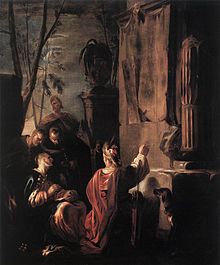
Based on such accounts of Scythian founders of certain Germanic as well as Celtic tribes, British historiography in the British Empire period such as Sharon Turner in his History of the Anglo-Saxons , made them the ancestors of the Anglo-Saxons.[ citation needed ]
Characteristically, early modern English discourse on Ireland, such as that of William Camden and Edmund Spenser, frequently resorted to comparisons with Scythians in order to confirm that the indigenous population of Ireland descended from these ancient "bogeymen," and showed themselves as barbaric as their alleged ancestors. [7] [8]
Legends about the origin of the population from the Scythian ancestor Targitaos – son of Borysthenes's daughter (that was the name of the Dnipro river in antiquity) – are popular in Ukraine. In Ukraine, which territory Herodotus of Halicarnassus described in his work on the Scythians, there are discussions about how serious the influence of the Scythians was on the ethnogenesis of Ukrainians. [9] Currently, there are studies that indicate the relationship of Slavic tribes living in Ukraine with the Scythian plowmen (plough man) and farmers who belonged to the Proto-Slavic Chernoles or Black Forest culture. [10] [11] The description of Scythia by Herodotus is also called the oldest description of Ukraine. [12] Despite the absolute dissimilarity of modern Ukrainian and hypothetical Scythian languages, researchers claim it still left some marks, [13] such as the fricative pronunciation of the letter "г," the specific alternation, etc. [14]

The Scythians or Scyths in composition) and sometimes also referred to as the Pontic Scythians, were an ancient Eastern Iranic equestrian nomadic people who had migrated during the 9th to 8th centuries BC from Central Asia to the Pontic Steppe in modern-day Ukraine and Southern Russia, where they remained established from the 7th century BC until the 3rd century BC.
In Irish mythology, *Danu is the reconstructed mother goddess of the Tuatha dé Danann. Though primarily seen as an ancestral figure, some Victorian sources also associate her with the land.
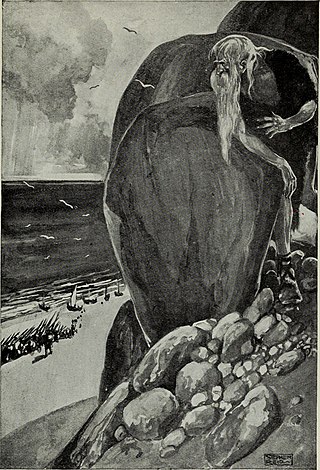
Nemed or Nimeth is a character in medieval Irish legend. According to the Lebor Gabála Érenn, he was the leader of the third group of people to settle in Ireland: the Muintir Nemid, Clann Nemid or "Nemedians". They arrived thirty years after the Muintir Partholóin, their predecessors, had died out. Nemed eventually dies of plague and his people are oppressed by the Fomorians. They rise up against the Fomorians, attacking their tower out at sea, but most are killed and the survivors leave Ireland. Their descendants become the Fir Bolg and the Tuatha Dé Danann.
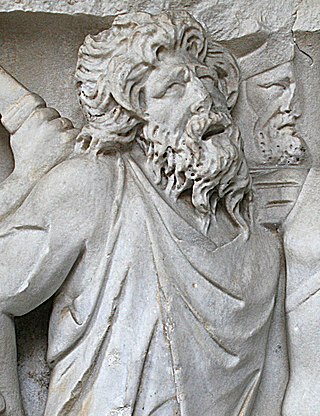
The Sarmatians were a large confederation of ancient Eastern Iranian equestrian nomadic peoples of classical antiquity who dominated the Pontic steppe from about the 3rd century BC to the 4th century AD.

In Irish origin myths, Míl Espáine or Míl Espáne is the mythical ancestor of the final inhabitants of Ireland, the "sons of Míl" or Milesians, who represent the vast majority of the Irish Gaels. His father was Bile, son of Breogan. Modern historians believe he is a creation of medieval Irish Christian writers.

In the Lebor Gabála Érenn, a medieval Irish Christian pseudo-history, the Milesians or sons of Míl are the final race to settle in Ireland. They represent the Irish people. The Milesians are Gaels who sail to Ireland from Iberia (Hispania) after spending hundreds of years travelling the earth. When they land in Ireland they contend with the Tuatha Dé Danann, who represent the Irish pantheon of gods. The two groups agree to divide Ireland between them: the Milesians take the world above, while the Tuath Dé take the world below.

The Neuri were an ancient Baltic people whose existence was recorded by ancient Graeco-Roman authors.

Lebor Gabála Érenn, Modern Irish spelling: Leabhar Gabhála Éireann) known in English as The Book of Invasions, is a collection of poems and prose narratives in the Irish language intended to be a history of Ireland and the Irish from the creation of the world to the Middle Ages. There are a number of versions, the earliest of which was compiled by an anonymous writer in the 11th century. It synthesised narratives that had been developing over the foregoing centuries. The Lebor Gabála tells of Ireland being settled six times by six groups of people: the people of Cessair, the people of Partholón, the people of Nemed, the Fir Bolg, the Tuatha Dé Danann, and the Milesians. The first four groups are wiped out or forced to abandon the island; the fifth group represents Ireland's pagan gods, while the final group represents the Irish people.

The Mythological Cycle is a conventional grouping within Irish mythology. It consists of tales and poems about the god-like Tuatha Dé Danann, who are based on Ireland's pagan deities, and other mythical races such as the Fomorians and Fir Bolg. It is one of the four main story 'cycles' of early Irish myth and legend, along with the Ulster Cycle, the Fianna Cycle and the Cycles of the Kings. The name "Mythological Cycle" seems to have gained currency with Arbois de Jubainville c. 1881–1883. James MacKillop says the term is now "somewhat awkward", and John T. Koch notes it is "potentially misleading, in that the narratives in question represent only a small part of extant Irish mythology". He prefers T Ó Cathasaigh's name, Cycle of the Gods. Important works in the cycle are the Lebor Gabála Érenn, the Cath Maige Tuired, the Aided Chlainne Lir and Tochmarc Étaíne.
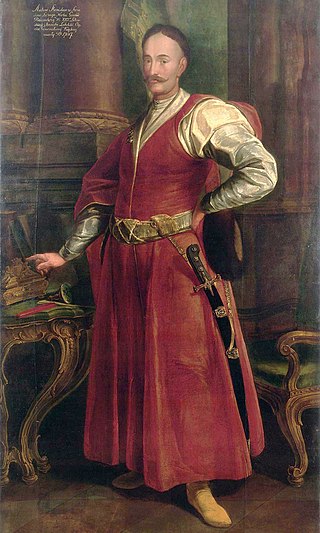
Sarmatism was an ethno-cultural ideology within the Polish–Lithuanian Commonwealth. It was the dominant Baroque culture and ideology of the nobility that existed in times of the Renaissance to the 18th centuries. Together with the concept of "Golden Liberty", it formed a central aspect of the Commonwealth's culture and society. At its core was the unifying belief that the people of the Polish–Lithuanian Commonwealth descended from the ancient Iranian Sarmatians, the legendary invaders of contemporary Polish lands in antiquity.
Géde Ollgothach, son of Ollom Fotla, was, according to medieval Irish legend and historical tradition, a High King of Ireland. He succeeded to the throne on the death of his brother Slánoll. His epithet means "possessing a great voice", and the Lebor Gabála Érenn says during his reign all his subjects had voices as sweet as the strings of a zither. He ruled for eight, or twelve, or seventeen years, before being killed by, according to the Lebor Gabála, the otherwise unknown Fíachu son of Fíadchú; according to Geoffrey Keating and the Annals of the Four Masters, by his nephew and successor Fíachu Findoilches, son of Fínnachta. The chronology of Keating's Foras Feasa ar Éirinn dates his reign to 880–863 BC, that of the Annals of the Four Masters to 1241–1231 BC.

In medieval Irish and Scottish legend, Scota or Scotia is the daughter of an Egyptian pharaoh and ancestor of the Gaels. She is said to be the origin of their Latin name Scoti, but historians say she was created to explain the name and to fit the Gaels into a historical narrative.

The Arimaspi were a legendary tribe of one-eyed people of northern Scythia who lived in the foothills of the Riphean Mountains, variously identified with the Ural Mountains or the Carpathians. All tales of their struggles with the gold-guarding griffins in the Hyperborean lands near the cave of Boreas, the North Wind (Geskleithron), had their origin in a lost work by Aristeas, reported in Herodotus.
Fénius Farsaid is a legendary king of Scythia who appears in different versions of Irish mythology. He was the son of Boath, a son of Magog. Other sources describe his lineage from the line of Gomer. According to some traditions, he invented the Ogham alphabet and the Gaelic language.
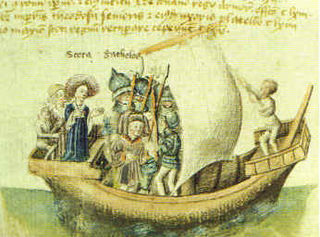
In medieval Irish and Scottish legend, Goídel Glas is the creator of the Goidelic languages and eponymous ancestor of the Gaels. The tradition can be traced to the 11th-century Lebor Gabála Érenn. A Scottish variant is recorded by John of Fordun.
Lámfhind, son of Agnoman, was, according to medieval Irish historical traditions, a mythical ancestor of the Milesians, who are said to have settled Ireland from the Iberian Peninsula and from whom the lineages of most of the traditional High Kings were traced.
Rudraige mac Sithrigi, was, according to medieval Irish legend and historical tradition, a High King of Ireland. The son of Sitric, he took power after killing his predecessor, Crimthann Coscrach, and ruled for thirty or seventy years, after which he died of plague in Airgetglenn. He was succeeded by Finnat Már, son of Nia Segamain. He is the ancestor of Clanna Rudraige.

Baath or Baath mac Magog is a figure in Irish legendary history. He was a son of Magog, son of Japheth, the progenitor of the Scythians, son of Noah, and the father of Fénius Farsaid, according to a version "M" of Lebor Gabála Érenn, also known as the Great Book of Lecan. He is described as being from Scythia, and the Goths, or the Gaedil. According to the same version of the story, he had four brothers, Ibath, Barachan, Emoth, and Aithechta. But the story further states that "...Feinius Farrsaid was son of Baath, son of Ibath, son of Gomer, and son of Iafeth (Japheth)".